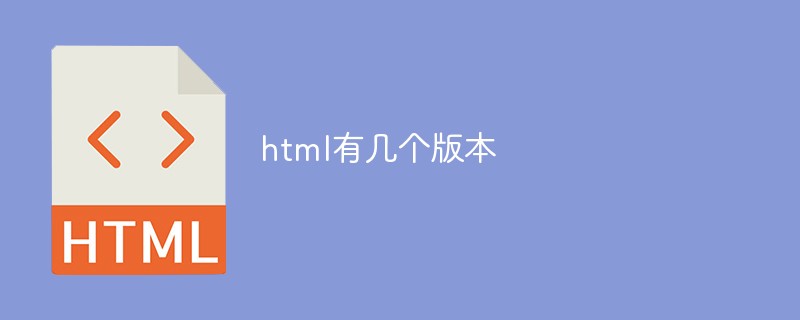There are several versions of html
html has 8 versions: 1. "HTML 1.0"; 2. "HTML 2.0"; 3. "HTML 3.2"; 4. "HTML 4.0"; 5. "HTML 4.01"; 6. " XHTML 1.0"; 7. "HTML5"; 8. "XHTML5".

The operating environment of this tutorial: Windows 7 system, HTML5 version, Dell G3 computer.
HTML stands for Hypertext Markup Language and is a markup language. It includes a series of tags. These tags can unify the document format on the network and connect scattered Internet resources into a logical whole. HTML text is descriptive text composed of HTML commands. HTML commands can describe text, graphics, animations, sounds, tables, links, etc.
HTML Version
Since the early days of the Web, multiple HTML versions have been developed:
| Version | Year | Description |
|---|---|---|
| HTML 1.0 | 1993 | In 1993 Released as an Internet Engineering Task Force (IETF) working draft in June. |
| HTML 2.0 | 1995 | was released as RFC 1866 in January 1995 and was declared obsolete after its release in June 2000. |
| HTML 3.2 | 1997 | January 14, 1997, W3C recommended standard. |
| HTML 4.0 | 1997 | December 18, 1997, W3C recommended standard. |
| HTML 4.01 (minor improvements) | 1999 | December 24, 1999, W3C recommended standard. |
| XHTML 1.0 | 2000 | |
| 2012 | HTML5 is recognized as the next generation Web language, which has greatly improved the Web's capabilities in rich media, rich content and rich applications, and is hailed as an important driving force that will eventually change the mobile Internet. Internet Explorer 8 and earlier versions are not supported. | |
| 2013 |
The above is the detailed content of There are several versions of html. For more information, please follow other related articles on the PHP Chinese website!

Hot AI Tools

Undresser.AI Undress
AI-powered app for creating realistic nude photos

AI Clothes Remover
Online AI tool for removing clothes from photos.

Undress AI Tool
Undress images for free

Clothoff.io
AI clothes remover

AI Hentai Generator
Generate AI Hentai for free.

Hot Article

Hot Tools

Notepad++7.3.1
Easy-to-use and free code editor

SublimeText3 Chinese version
Chinese version, very easy to use

Zend Studio 13.0.1
Powerful PHP integrated development environment

Dreamweaver CS6
Visual web development tools

SublimeText3 Mac version
God-level code editing software (SublimeText3)

Hot Topics
 1378
1378
 52
52
 Table Border in HTML
Sep 04, 2024 pm 04:49 PM
Table Border in HTML
Sep 04, 2024 pm 04:49 PM
Guide to Table Border in HTML. Here we discuss multiple ways for defining table-border with examples of the Table Border in HTML.
 HTML margin-left
Sep 04, 2024 pm 04:48 PM
HTML margin-left
Sep 04, 2024 pm 04:48 PM
Guide to HTML margin-left. Here we discuss a brief overview on HTML margin-left and its Examples along with its Code Implementation.
 Nested Table in HTML
Sep 04, 2024 pm 04:49 PM
Nested Table in HTML
Sep 04, 2024 pm 04:49 PM
This is a guide to Nested Table in HTML. Here we discuss how to create a table within the table along with the respective examples.
 HTML Table Layout
Sep 04, 2024 pm 04:54 PM
HTML Table Layout
Sep 04, 2024 pm 04:54 PM
Guide to HTML Table Layout. Here we discuss the Values of HTML Table Layout along with the examples and outputs n detail.
 HTML Input Placeholder
Sep 04, 2024 pm 04:54 PM
HTML Input Placeholder
Sep 04, 2024 pm 04:54 PM
Guide to HTML Input Placeholder. Here we discuss the Examples of HTML Input Placeholder along with the codes and outputs.
 HTML Ordered List
Sep 04, 2024 pm 04:43 PM
HTML Ordered List
Sep 04, 2024 pm 04:43 PM
Guide to the HTML Ordered List. Here we also discuss introduction of HTML Ordered list and types along with their example respectively
 Moving Text in HTML
Sep 04, 2024 pm 04:45 PM
Moving Text in HTML
Sep 04, 2024 pm 04:45 PM
Guide to Moving Text in HTML. Here we discuss an introduction, how marquee tag work with syntax and examples to implement.
 HTML onclick Button
Sep 04, 2024 pm 04:49 PM
HTML onclick Button
Sep 04, 2024 pm 04:49 PM
Guide to HTML onclick Button. Here we discuss their introduction, working, examples and onclick Event in various events respectively.




